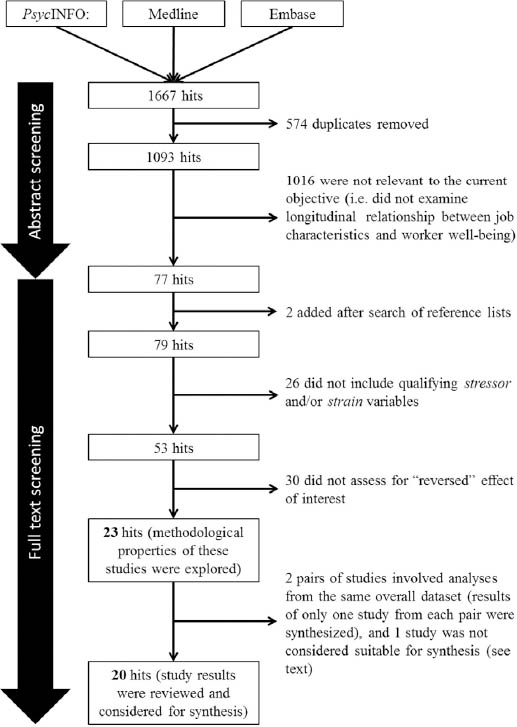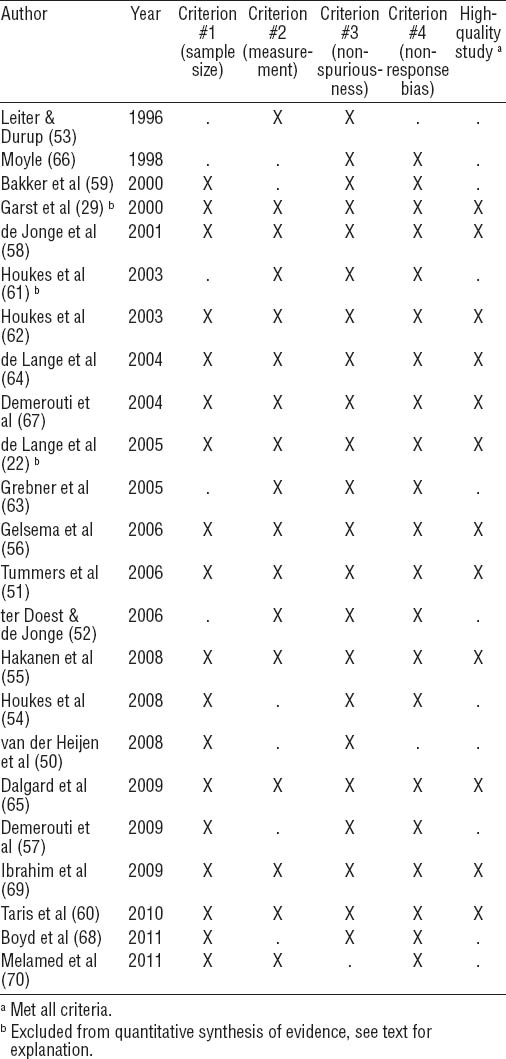In recent years, much research attention has been dedicated to understanding the relationship between adverse psychosocial working conditions (ie, stressors) and worker well-being (ie, strain). A number of theoretical models have also emerged, hypothesizing pertinent sources of job stress and their consequences. A prominent example is the Demand–Control–Support (DCS) model (1, 2), which posits that high psychological job demands, low job control, and/or low workplace social support are detrimental to worker well-being (3–5). Accordingly, many studies in the current literature have focused on elucidating various stressor-to-strain effects as postulated by the DCS model (5–7).
In his social cognitive theory, Bandura (8, 9) posits that different variables (eg, behavior, person, or environment) may exert mutual influences on each other through bidirectional feedback loops. In other words, people are thought to be “both products and producers of their environment” and not just passive recipient of environmental influences over the course of lifespan development (8, 10, 11). In line with this notion of “reciprocal determinism”, scholars are increasingly postulating a reciprocal (bidirectional) occupational stressor–strain relationship, where not only job stressors can influence worker well-being (ie, “normal” or stressor-to-strain effect), but conversely, worker well-being can also have influence on the work environment (ie, “reversed” or strain-to-stressor effect) (5, 12–16). In the context of the DCS model, this implies job demands, job control, or workplace social support are a consequence of worker well-being.
In general, two main mechanisms have been proposed to explain the reversed effect (ie, a positive association between strain and subsequent level of a stressor). First, the “health selection” hypothesis posits that as healthy workers are likely to retain (or be promoted to) jobs with more favorable work environments (ie, upward selection), unhealthy workers (ie, strained) on the contrary are susceptible to drift off to more negative work environments with unfavorable job characteristics, such as greater job demands, less control, and/or less workplace social support (ie, downward selection, also known as the “drift” hypothesis) (12–14, 17). A number of contributing reasons for downward selection, in particular, have been put forth: (i) job performance may be negatively impacted for strained workers, which makes them susceptible to dismissal or being relegated to more undesirable or stressful work tasks (18); (ii) this also undermine their ability to negotiate favorable changes (within the same job), receive a job promotion, or secure employment with a new organization with favorable characteristics (10, 11, 18); (iii) depressed or emotionally exhausted workers may experience cognitive and/or behavioral withdrawal, which hinder their ability to develop and maintain a positive and collaborative rapport with supervisors and/or co-workers (15, 19, 20); (iv) strained workers may be especially challenged to make the significant investment of time/effort required to seek new jobs with more favorable characteristics; and lastly, (v) employers in desirable workplaces may also be reluctant to hire employees perceived to be unhealthy (18, 21).
The other commonly proposed mechanism is the “perception” hypothesis, which suggests that changes in worker well-being may lead to an altered evaluation of existing job characteristics, even though the work environment itself may be unchanged. The two sides of this effect have been coined the “rosy perception mechanism” and the “gloomy perception mechanism” (22). The former suggests that healthy workers are more likely to re-interpret their jobs positively over time as they are able to maintain engaged in their work, accumulate, and conserve job resources (eg, develop good rapport with co-workers), and ultimately, increase job proficiency (23). On the other hand, the gloomy perception mechanism suggests that strained workers may re-interpret their work environment more negatively over time due to a few reasons: (i) job demands are perceived as more burdensome as a worker’s capacity declines due to increased strain and/or poor health (24) and (ii) individuals with poor affective health (eg, negative moods, depressed) may exhibit a selective (increased) recall of negative information or situations (18, 25, 26), especially circumstances that are outside their control (eg, lack of job autonomy) (15, 27, 28).
Interestingly, a number of competing influences to the postulated “health selection” and “perception” hypotheses have also been proposed. For example, it is believed that some strained workers may in fact be able to successfully transfer to a new workplace with fewer stressors (eg, lower job demands). This is sometimes referred as the “refuge effect” (29), which counters the idea of downward selection. On the flip side, some healthy workers may be promoted to more senior positions or new jobs that exceed their capabilities (ie, an unfavorable change in work environment), which counteracts the idea of upward selection. Since work characteristics within the same job can evolve, the development of the gloomy perceptions hypothesis may be counteracted by effective “job crafting” (30) or modifications at work (employee-initiated) to improve fit between job characteristics and his or her own needs, abilities, and preferences (31). For example, some strained workers may be able to negotiate or make arrangements with managers to reduce their workload, and thus alleviate ongoing job stresses. On the other hand, if a manager sees untapped potential in some healthy workers, he may place additional workload on them and consequently dampen the development of rosy perceptions. If these collective (competing) influences are at-play, it is conceivable that the reversed effect may not materialize in the expected manner (ie, weak/no strain-to-stressor relationship).
To explore the notion of reciprocal determinism in the occupational stressor–strain relationship, the primary objective was to conduct a systematic literature review to determine the extent of empirical support for three reversed (strain-to-stressor) effects, guided by the DCS model. Specifically, it was hypothesized that evidence would emerge for: (i) a positive strain-to-job demands effect, (ii) a negative strain-to-job control effect, and (iii) a negative strain-to-workplace social support effect, consistent with the postulated health selection and perception hypotheses. Secondary objectives were to explore the methodological diversity of qualifying studies and provide a broad discussion on gaps in current understanding as well as potential “next step” research avenues.
Methods
Literature search strategy
Three electronic databases (PsycINFO, Medline, and Embase) were searched to identify relevant publications. The search was limited to publications between 1996 and 2012 (inclusive), coinciding with a previous notable review by Zapf et al (14) where more modern methods to investigate occupational stressor–strain relationships were advocated [eg, cross-lagged structural equation modeling (SEM)] (14). The initial search sought publications under relevant major subject headings (eg, “occupational stress” or “burnout”) and those that featured keywords related to both job stressor (eg, job characteristics, job demands, workload, supervisor support) and strain (eg, well-being, mental health, job satisfaction). Using the operator “AND”, these hits were combined with publications under the subject heading “longitudinal studies” and any additional publications that feature the term reciprocal*, reverse*, or cross-lagged as a keyword. This strategy initially led to 1667 hits (figure 1). After a screening of abstracts, the remaining publications were thoroughly examined for relevance and to identify additional publications from reference lists.
Inclusion and exclusion criteria
To be included, the study had to (i) be a longitudinal observational (ie, non-intervention) study, (ii) have investigated for a longitudinal reversed strain-to-stressor effect, and (iii) feature variables that meet the following requirements: (a) to qualify as strain, the variable should provide a direct indication of (impaired) physical, psychological, or general well-being. Examples of strain include psychosomatic symptoms/complaints, depressive mood, psychological distress, burnout (eg, emotional exhaustion, depersonalization), or job satisfaction; (b) to qualify as a stressor, the variable must quantify job demands, job control, workplace social support, or a more specific dimension of these constructs (eg, job autonomy, supervisor support). Studies in a language other than English were excluded. Following this study selection procedure, 23 journal articles met the inclusion/exclusion criteria, and all were explored to gain insights on methodological diversity. Then, a methodological quality appraisal was performed, and relevant findings from studies deemed to be of high-quality were synthesized to address the primary study question.
Appraisal of methodological quality
Based on insights gathered from previous systematic reviews in the field, four methodological features were considered most crucial for affirming the internal validity of any reported strain-to-stressor effects (ie, free from significant biases). To be considered of “high” methodological quality, an effect should be derived from a quantitative analysis that featured: (i) adequate sample size, (ii) appropriate measurement of the stressor/strain variables involved, (iii) considerations for spurious (or alternative) explanations of the observed strain–stressor relationship [ie, the “third variable” issue (14, 32, 33)], and (iv) no evidence of significant non-response bias. Since these were considered fundamentally important methodological features, only studies that met all four of the proposed quality criteria (described below) were deemed to be of high quality.
Sample size
Although its importance is well-recognized in quantitative research, the sample size requirement for statistical modeling currently remains a much-debated topic. In fact, experts have suggested that the required sample size for an SEM may depend on a myriad of factors, including model complexity, estimation method used, distributional characteristics of the observed variables, amount of missing data, reliability of the variables, and expected strength of the relationships among the variables (34, 35). As such, liberal rule-to-thumb guidelines were applied in this review. For SEM, a sample size of N≥200 was expected based on Kline’s recommendation (35). For multiple regressions, a sample size-to-number of independent variable ratio of 10 was sought (36, 37).
Measurement
Suboptimal measurement can represent a potential source of bias when quantifying relationships between constructs. In the current context, adequate measurement of the stressor/strain variables is paramount. This can be ascertained in a study by providing indications of the psychometric soundness of the measures employed, and/or by applying analytic strategies that consider measurement error. This criterion was satisfied if the study had incorporated measurement models of stressor/strain variables in a SEM, affirmed the adequacy of the factor structure of these variables (eg, by conducting a factor analysis), or affirmed the internal consistency of these variables at all time-points in accordance to the standard by Nunnally (38) (ie, Cronbach’s alpha ≥0.7).
Non-spuriousness
For non-experimental designs, consideration of alternative explanations is an important aspect of deducing causal inferences between variables of interest (32, 33, 39). As such, it is imperative that a study considers whether an alternative variable(s) might be responsible for (or have artificially inflated) the observed longitudinal stressor–strain association. Notable third variables that have received some attention include personal disposition factors such as neuroticism (40), locus of control (41), and negativity affectivity (42, 43). Moreover, as self-reported measures are predominantly employed in job stress research, common method variance has also been raised as a potential source of bias (44–46). Techniques to explore the influence of measured or unmeasured third variables may include testing a common factor model (ie, both stressor and strain variables are assumed to originate from an underlying higher-order factor) or accounting for potential confounders in the analysis, although much debate currently exists on the need to adjust for personal disposition factors (42). To meet this criterion, it was expected that lagged (strain-to-stressor) effects must have accounted (statistically adjusted) for the same stressor variable at the previous time-point(s). More specifically, SEM were expected to have specified autoregressive paths (or autocorrelations) between measurement waves; for multiple regressions, the initial level of stressor was expected to have been included as an independent variable.
Non-response bias
As subject attrition is common in longitudinal studies, evidence of the absence of selection bias is important to help ascertain the validity of observed effects. To satisfy this criterion, evidence to support no significant differences between responders (ie, stayers) and non-responders (eg, eventual dropouts) within the study was expected. Indication of non-response bias may involve substantial differences in baseline characteristics (eg, involving >50% of traits assessed or involving key stressor/strain variables) or significant difference in the magnitude of baseline stressor–strain associations between stayers and eventual dropouts.
Synthesis of evidence
To determine strength of cumulative evidence, a standardized index of convergence (SIC) (47) was calculated for each of the three reversed effects (strain-to-job demands/job control/workplace social support), based on evidence derived only from high-quality studies. This is considered a feasible, quantitative approach to inform the strength of cumulative evidence (based on a comparison of number of significant versus non-significant findings), particularly in situations where a meta-analysis is not ideal due to the heterogeneity of available studies (eg, differences in variables, instruments, analytic approaches) (47). SIC is defined as:
where n[positive] represents the number of studies reporting a significant positive association, n[negative] represents the number of studies reporting a significant negative association, and n[total] represents the total number of studies that examined a given strain-to-stressor effect, including those reporting no significant associations (47). As such, the SIC value provides an indication of the consistency of evidence regarding a particular relationship, which ranges between -1 (all studies reporting a negative association) and +1 (all studies reporting a positive association). A value close to 0 would indicate that the cumulative evidence is either inconsistent or that only a small proportion of studies were able to detect a significant association.
For each of the three reversed effects, each study can contribute one (overall) rating to SIC calculations. This rating can be either a “+” to indicate a positive association, “–” to indicate a negative association, or “0” to indicate no statistically significant association based on an alpha level of 0.05. Where a statistical model had been built sequentially (eg, stepwise addition of covariates), only the most advanced (well-adjusted) model was considered. If comparison of alternative SEM specifications were conducted, only the best-fitting (“final”) model (as declared by the authors) was considered. If multiple tests/analyses on the same reversed effect were performed within a study (eg, ≥2 measurement waves, several closely related qualify in stressor/strain variables were included, conducted subgroup analyses), then a decision tree was applied to derive a single, overall study rating based on results from all relevant tests (48, 49) (figure 2).
Figure 2
Decision rule for deriving a single overall study rating when a “reversed” effect of interest is assessed multiple times within a single study (eg, multiple samples, subgroup analyses, ≥2 measurement waves, multiple outcomes) and inconsistent associations are observed [+ = positive association; – = negative association; 0 = no association]. Note: where >3 associations are tested within a single study, ≥50% of the results in the same direction is needed for the overall study rating to be assigned that same direction (adapted from Nijp HH et al, Scand J Work Environ Health. 2012;38(4):299–313, with permission).

The strength of evidence for a specific reversed effect is determined by both the SIC value and the total number of studies examining that very relationship. Table 1 shows the possible outcomes. By this approach, a large number of relevant studies combined with consistent associations in the same direction (ie, high SIC value) would suggest high strength of evidence (eg, “strong” or “moderately strong”). On the other hand, a low number of relevant studies combined with a lack of (or inconsistent) associations (ie, low SIC value) would suggest weak strength of evidence (eg, “limited” or “inconsistent/no”).
Table 1
Assessment of strength of evidence based on the total number of relevant studies and the standardized index of convergence (SIC) value derived from cumulative study findings (adapted from Van Laethem et al, Scand J Work Environ Health. 2013; 39(6):535–549, with permission). [0 = inconsistent/no evidence for a positive/negative relationship; –/+ = limited evidence for a positive/negative relationship; – –/+ + = moderately strong evidence for a positive/negative relationship; – – –/+ + + = strong evidence for a positive/negative relationship; # = insufficient evidence]

Results
Methodological properties of studies
Among the 23 qualifying studies, considerable variation in methodological properties was found (table 2). In terms of sampling strategy, studies either recruited workers from a specific profession (eg, dentists) or the same work organization (eg, a bank) or utilized data from regional registries (included diverse types of workers). Workers in healthcare settings (eg, clinicians and support staff) were investigated most often (N=10) (50–59). Of the 18 studies originating from Europe (22, 29, 50–52, 54–67), 14 were from The Netherlands. The remaining four were from Australia (68), Canada (53, 69), and Israel (70). Sample size ranged from 52–2255, and study duration ranged from 3 months to as long as 11 years. Sixteen studies featured two measurement waves (50–56, 58–63, 65, 68, 70), four featured three waves (57, 66, 67, 69), two featured four waves (22, 64), and one study featured six measurement waves (29). Of note, eight studies explicitly indicated that job changers (over the course of the study) were excluded from analysis (52, 56, 57, 59, 64, 65, 67, 70).
Table 2
Overview of studies reviewed. [Analytic method=measurement models specified yes/no; CFA=confirmatory factor analysis; NL=The Netherlands; PCA=principal component analysis; SEM=structural equation modeling; T=time; n/a=not applicable.]
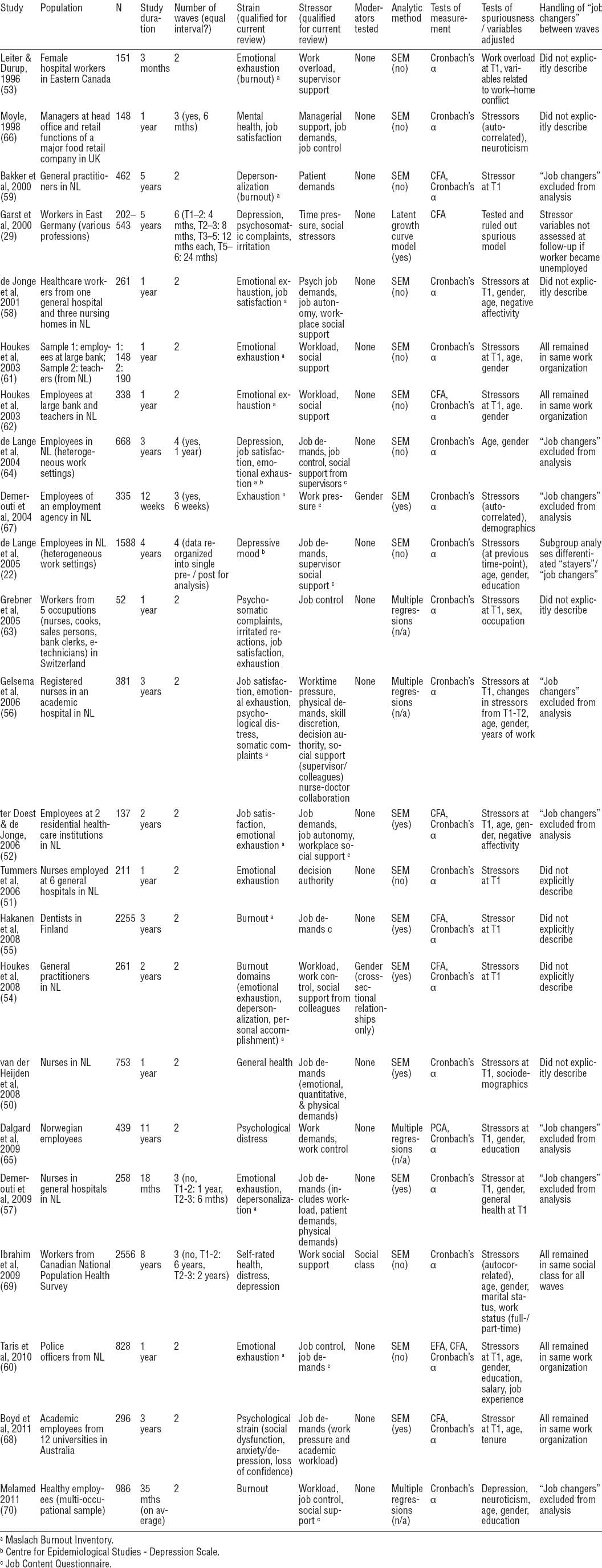
The 23 qualifying studies also featured varied combinations of stressor/strain variables. The range of strain variables included constructs related to psychosomatic complaints, depression, psychological distress, general health, and burnout. Among them, dimensions of burnout (especially emotional exhaustion) were most commonly assessed, using the Maslach Burnout Inventory (71, 72) in most cases. In terms of stressors, most studies employed subscales from the Job Content Questionnaire (73, 74) to quantify job demands and job control, while a few studies employed more specific constructs tailored to their population (eg, patient demands for healthcare professionals). Specific measures chosen to capture workplace social support were highly diverse. All studies relied entirely on self-report measures, except for one which incorporated observer ratings of job control (63).
Design and analytic approaches
In terms of analytic approach, 18 studies applied SEM techniques to evaluate strain-to-stressor effects, often under the context of comparing hypotheses on casual directionality (ie, normal versus reversed versus reciprocal models). Other approaches included a latent growth curve analysis (N=1) and multiple regressions (N=4). Only two studies evaluated a moderator (for a reversed effect of interest), which included gender (67) and social class (69). Psychometric diligence was routinely observed as all included studies made efforts to verify either the internal consistency (N=22) and/or the adequacy of the factor structure (N=7) of the key stressor/strain measures employed. In addition, eight studies incorporated measurement models (using either scale items or subdomains as indicators) in their SEM/growth curve model. Several noteworthy efforts to consider/rule out alternative (or spurious) explanations of the stressor–strain relationship were found. Four studies incorporated either negative affectivity (52, 58) or neuroticism (66, 70) into their analyses, and one other study assessed (and ruled-out) the fit of a common factor model (29).
Appraisal of methodological quality
Of the 23 qualifying studies, the sample size criterion was met in 18 studies, the measurement criterion was met in 17 studies, the non-spuriousness criterion was met in 22 studies, and the non-response bias criterion was met in 21 studies. Taken together, 12 of 23 studies (52%) met all four methodological quality criteria and were therefore considered to be of high quality (table 3).
Synthesis of evidence
Some additional considerations were needed prior to the review and synthesis of findings from individual studies. During the appraisal process, it was recognized that two pairs of studies analyzed data drawn from the same dataset. This involved two studies by de Lange et al (22, 64) and two studies by Houkes et al (61, 62). To avoid double-counting, it was determined that only one of each pair of studies should be counted. The earlier study by de Lange et al (64) was included, since its design more fully utilized its four-wave data; the other study re-organized the data into a single pre- versus post- analysis (22). Houkes et al (62) was included since it met the sample size criterion, whereas the other study used two smaller samples neither of which met the sample size criterion (61). Furthermore, it was also determined that the results from Garst et al (29) should be excluded for two reasons: (i) only the relationship between initial level of strain and the magnitude of change in stressor over time was assessed (ie, an intercept-slope relationship), which differs from an association between initial and final states which was most typically assessed; (ii) statistical significance for such intercept-slope relationships was not reported in the publication. Lastly, the study by Melamed et al (70) assessed for both state-to-state and state-to-change associations. Therefore, to be consistent with other included studies, only the analyses examining state-to-state associations were considered for synthesis. Ultimately, this meant that the results from a total of 20 unique qualifying (10 high quality) studies were considered. Of these, 17 (8 high quality) studies contributed evidence to the strain-to-job demands effect (table 4a), 11 (6 high quality) studies contributed evidence to the strain-to-job control effect (table 4b), and 10 (5 high-quality) studies contributed evidence to the strain-to-workplace social support effect (table 4c).
Table 4a
Synthesis of evidence from individual studies (ordered by time-lag duration). Strain-to-job demands effect (17 total studies, 8 high-quality studies). [apriori hypothesis=POSITIVE association; Italicized effects=“strain” indicator has opposite orientation, direction of observed association is reversed for purpose of determining overall study rating (“–” actually means “+”)]
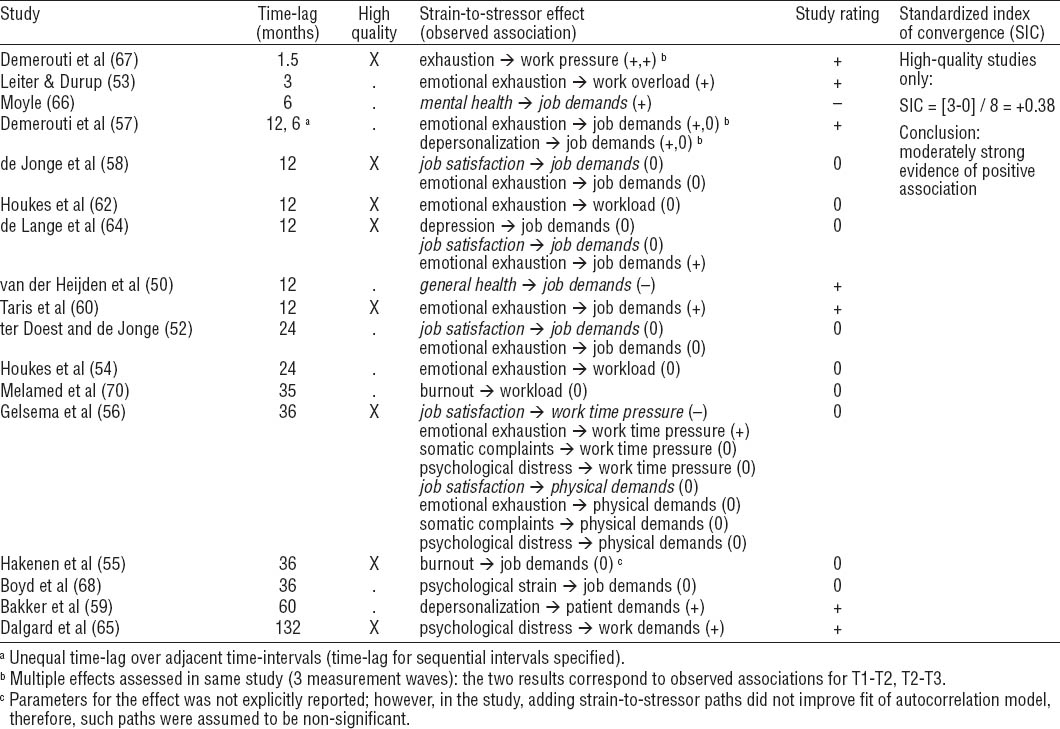
Table 4b
Synthesis of evidence from individual studies (ordered by time-lag duration) Strain-to-job control effect (11 total studies, 6 high-quality studies). [apriori hypothesis=NEGATIVE association; Italicized effects=“strain” indicator has opposite orientation, direction of observed association is reversed for purpose of determining overall study rating (“–” actually means “+”)]
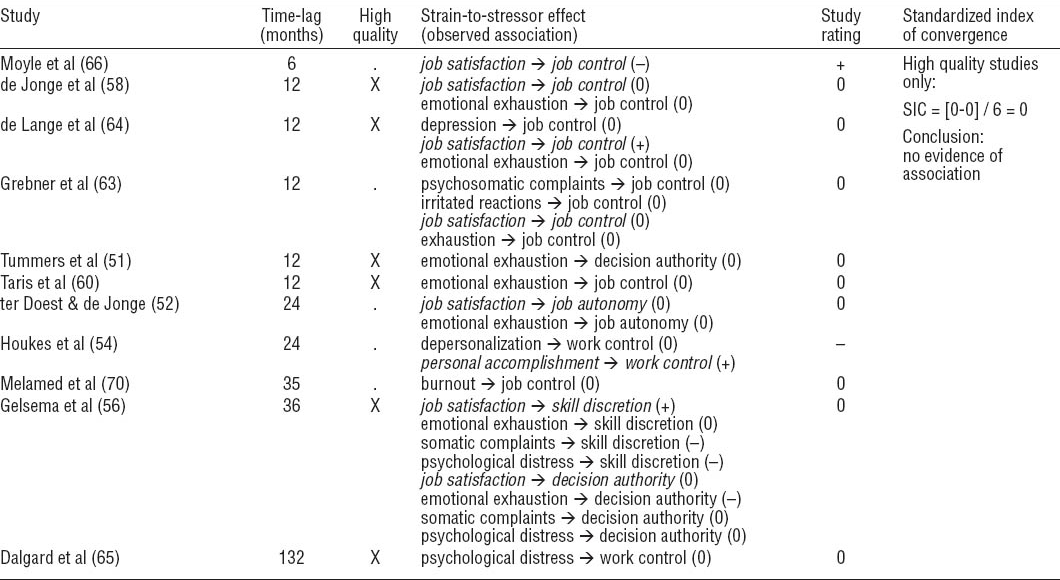
Table 4c
Synthesis of evidence from individual studies (ordered by time-lag duration). Strain-to-workplace social support effect (10 total studies, 5 high-quality studies). [apriori hypothesis=NEGATIVE association; Italicized effects=“strain” indicator has opposite orientation, direction of observed association is reversed for purpose of determining overall study rating (“–” actually means “+”)]
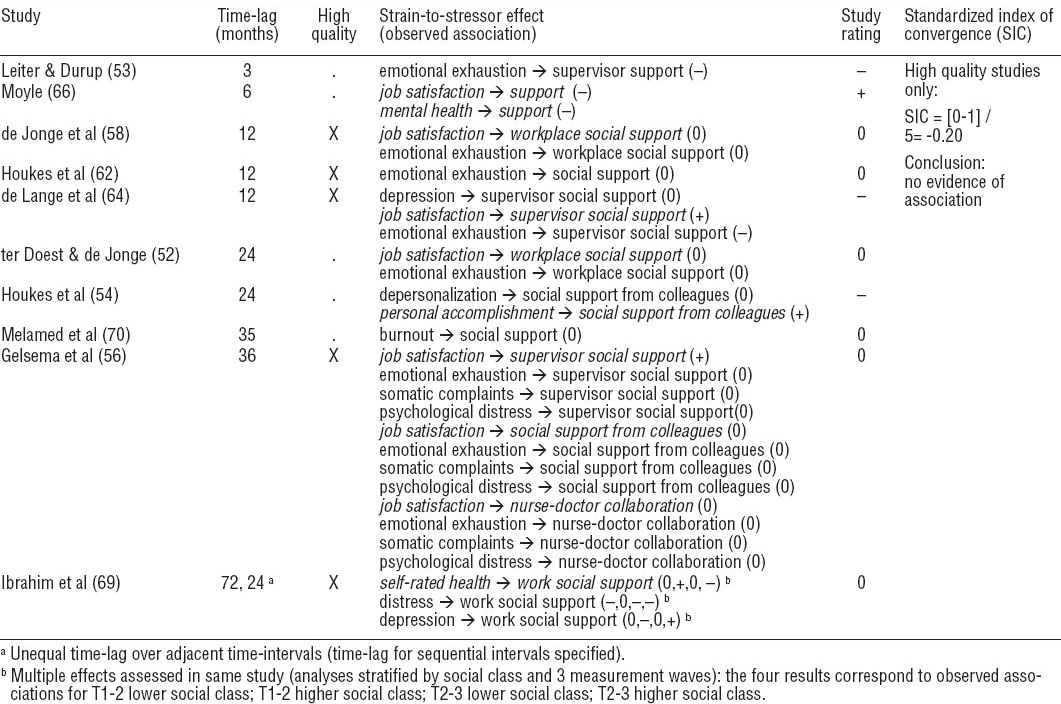
The strain-to-job demands effect
Of the eight high-quality studies that contributed evidence to the strain-to-job demands effect, a “+” rating (ie, supporting a positive association) was assigned to three studies; no studies were assigned a “–” rating (ie, supporting a negative association); and five studies were assigned a “0” rating (ie, no/inconsistent associations) (table 4a). Collectively, these ratings corresponded to an SIC value of +0.38, indicating “moderately strong” evidence for a positive strain-to-job demands effect, consistent with the hypothesized reversed effect (ie, greater initial strain leads to greater future job demands).
The strain-to-job control effect
Of the six high-quality studies that contributed evidence to the strain-to-job control effect, all six were assigned a study rating of “0” (table 4b). This corresponded to an SIC value of 0, indicating no evidence in support of a strain-to-job control effect (in either direction).
The strain-to-workplace social support effect
Of the five high-quality studies that examined a strain-to-workplace social support effect, none were assigned a “+” study rating, one was assigned a “–” study rating, and four were assigned a “0” study rating (table 4c). Collectively, these ratings corresponded to an SIC value of -0.20, indicating no evidence for a strain-to-workplace social support effect (in either direction).
Discussion
This main aim of this study was to conduct a systematic review of evidence on three specific reversed (strain-to-stressor) effects. Emerging attention on this topic should be regarded as a positive development in the field, as reversed effects have historically been somewhat overlooked (13, 14). In a previous review by Zapf et al (14), the reversed effect was explored in only 15 of 39 (38%) longitudinal job stress studies (supporting evidence shown in seven studies). Likewise, a more recent systematic review of longitudinal studies on the DCS model found only 2 of 19 (11%) high-quality studies explicitly tested for the reversed effect (5). As a whole, methodological sophistication was evident as 19 of 23 (83%) qualifying studies employed “state-of-the-art” analytic approaches advocated by experts (eg, cross-lagged SEM or latent growth curve model) (13, 14, 33, 75), compared to only 6 of 15 (40%) relevant studies in Zapf et al (14). Based on a synthesis of high-quality evidence, the current review found empirical support for only one of three hypothesized reversed effects. Specifically, there was moderately strong evidence in support of a positive strain-to-job demands effect, but no evidence for either a strain-to-job control or strain-to-workplace social support effect.
Generalizability of results
It is noteworthy that, for each of the three reversed effects examined, there was some inconsistency in the ratings among individual studies (ie, +, –, or 0 were all found). Moreover, it was also apparent that a rating of “0” (no/inconsistent association(s)) was most commonly assigned to the high-quality studies. This underscores the potential complexity of the strain-to-stressor relationship and raises the natural issue of generalizability. As discussed at the outset, there are potential competing forces (eg, refuge effects, job crafting) to both the health selection and perception hypotheses, and current results suggest these influences may indeed be of some relevance. In fact, significant strain-to-stressor associations opposite to the expected direction were found in three of the included studies (29, 66, 70). Furthermore, in a study specifically designed to explore mechanisms, de Lange et al (22) found that, like healthy workers, unhealthy (strained) workers also benefited from a job change in the form of improved job control, offering support to the idea of a refuge effect. If the hypothesized reversed effect is only to be seen in some situations, perhaps a logical next question is under what circumstances are they more/less likely observed? Arguably, this points to the need for additional studies that “go beyond” a sample-level analysis to explore variations in strain-to-stressor effects between subgroups or test potential moderating factors. Only two did so among the studies reviewed, and neither gender (67) nor social class (69) were revealed to be significant moderating factors based on respective multiple-group analyses.
The issue of measurement time-lag
Measurement time-lag stood out as a methodological property that varied widely across individual studies (3 months to 11 years). Could this have played a role in the partial generalizability of results? The ideal time-lag for longitudinal job stress research, unfortunately, has remained a long-standing methodological issue (14, 33, 64, 76, 77), and definitive insights remain elusive to-date. In theory, if the time-lag is too short, meaningful health selection or changes in the perception of the work environment may not have sufficiently unfolded. On the other hand, an excessively long time-lag may provide more opportunities for adaptations that could negate the anticipated reversed effect (14, 78, 79). If true, then perhaps one might expect reversed effects to be more likely seen with less extreme time-lags. Based on a limited number of qualifying studies in the review, however, there did not appear to be any obvious trends between time-lag and study rating. In fact, the expected reversed effects could be seen in four high-quality studies that featured highly distinct time-lags: very short (1.5 months) (67), average (12 months) (60, 64), and extremely long (132 months) (65). To shed further light on this issue in the future, perhaps two research avenues deserve considerations. One approach may involve conducting studies that directly compare strain-to-stressor effects over different time-lags (eg, baseline-to-1st follow-up versus baseline-to-2nd follow-up, etc.). Secondly, as more relevant studies emerge, a formal investigation of the relationship between methodological properties (including time-lag) and study results (eg, effect size) may also be worthwhile.
Disentangling between “health selection” and “perception” mechanisms
Which mechanism(s) is in fact responsible for the reversed effect? Currently, this remains unclear as few studies to-date have explicitly aimed to disentangle the relevance and contributions of the postulated health selection and perception hypotheses. A notable example, however, is de Lange et al (22), which conducted subgroup analyses aimed at discerning the mechanism(s) responsible. In this study, the authors concluded no single dominant mechanism for the reversed effect, as mild support for rosy/gloomy perception and upward health selection mechanisms (but not downward selection) was evident (22). Some insights were gained from the current review. Among the four high-quality studies that demonstrated the expected reversed effect, three had explicitly excluded job changers in their analyses (64, 65, 67), while the other study featured workers (police officers) who had remained at the same organization at follow-up (60). At first glance, this seemingly points to the perception mechanism, although in all these cases, health selection influences cannot be entirely ruled out, since (real) changes in the work environment is still possible without a formal job transfer (eg, workers given more/less job responsibilities, managerial changes, etc.). In the case of the latter study, the study sample may include workers who had undergone internal job changes (eg, promotions/demotions within the same organization). As such, it is not definitive that the reversed effects in these studies are solely due to perception changes.
Moving forward, further research to help unpack the contributing mechanisms of the reversed effect is certainly worthwhile, although important challenges from a design perspective should be recognized. A key conundrum would appear to be that very different designs may be needed to isolate effects linked to each of the two main postulated mechanisms. Moreover, in most cases, it is likely not possible to anticipate beforehand which mechanisms will be most involved (ie, difficult to know if and when job transfers will occur). Presumably, an examination of health selection may require a focus on workers who have undergone a meaningful change in the work environment and also the specific measurement waves that correspond to the occurrence of such a change. In this case, a relatively short time lag between pre- and post-change may be most desirable to minimize confounding influences (eg, to isolate from perception changes). Yet, in seemingly direct contrast, meaningful changes in the perception of the work environment may be best assessed over longer durations (to ensure changes in perception have fully consummated), but restricting to workers who had not experienced actual changes in the work environment (ie, to isolate from health selection influences). In all likelihood, it is perhaps simply too much to expect a single (and reasonably feasible) design to be able to capture and isolate these mechanisms precisely, particularly if they operate concurrently. As such, improvements in design may need to be explored elsewhere. Far from a panacea, perhaps an aspect of the design that can be more feasibly improved is the measurement of job-related changes between waves, as well as the description of such changes in scientific reports. In the current review, a number of studies appeared to have fallen short in this area (eight did not offer sufficient description of how job changers were handled). Beyond formal job transfers within or outside a work organization, future studies may also consider assessing for other (less drastic but also meaningful) job-related changes. This may include changes in work hours, significant changes in job responsibilities, or even managerial changes – all of which can occur while a worker occupies the same “job” (or job title) over time. At the very least, more comprehensive measurement in this regard should help researchers distinguish between workers who had or had not experienced “real” changes in the work environment (beyond job transfers), thus potentially enabling more definitive conclusions to be drawn in terms of the contributing mechanism(s).
Propagation of reciprocal stressor–strain effects over time
Do reciprocal stressor–strain effects persist over time? Drawing on the conservation of resources theory (80, 81), scholars are beginning to explore the relevance of gain/loss spirals in the context of the occupational stressor–strain relationship (82–84). Accordingly, this was also revealed to be a key theoretical basis/impetus for many of the studies reviewed. Briefly, the conservation of resources theory posits that psychological stress occurs “when resources (eg, objects, conditions, personal characteristics, and energies – things that people are motivated to acquire or value) are threatened, lost, or when individuals invest resources and do not reap the anticipated level of return” (85, p117). Moreover, it is believed that each loss depletes the available resources for confronting the next threat or loss, making one more vulnerable to additional resource losses. Thus, “initial loss begets future loss” and a loss spiral could ensue (81, p354). Along the same lines, gain spirals have also been theorized (86). If true, cycles of positive or negative influence may be characteristic of occupational stressor–strain relationships. To better understand the relevance and nature of gain/loss spirals, insights on the propagation of the reversed (as well as the normal) effects over multiple time-intervals (ie, more than two measurement waves) are needed. Unfortunately, the current review offered limited insights, as relatively few studies had employed more than two waves, and the available findings were also somewhat conflicting. In Demerouti et al (67), there was remarkable consistency in the magnitude of both normal and reversed effects between adjacent time-intervals (parameter estimates of corresponding relationships were identical between T1-2 and T2-3), suggesting strong persistence of effects over time. Likewise, the four-wave study by de Lange et al (64) found that constraining all corresponding (normal and reversed) effects to be equal across adjacent time-intervals led to the best-fitting model. On the other hand, however, persistence of reversed effects was not seen in Demerouti et al (57), where a significant positive strain-to-job demands effect was observed between T1 and T2, but not between T2 and T3 (no association). Nonetheless, more such studies would be worthwhile to shed further light on the relevance and nature of gain/loss spiral mechanisms in the context of occupational stressor–strain relationships.
Study limitations
Several study limitations should be considered. It should be recognized that reversed effects involving other work-related stressors/outcomes have also been tested in the literature. For example, the reciprocal relationships involving job insecurity (69, 87), effort–reward imbalance (88), or constructs involved in the work motivational process of the Job Demands–Resources model (eg, work engagement ↔ job resources) have also been previously explored (54, 55, 68). These were considered beyond the scope of the current review. Publication bias is possible in a systematic review focused on the peer-reviewed literature as studies with more novel findings (eg, significant reversed effect) may be more likely published than studies without such findings. That said, it was also apparent that, for each of the three reversed effects of interest, most included studies were ultimately assigned a study rating of “0”, and therefore, this form of bias did not appear to be strongly evident. Lastly, the current review did not involve inter-rater appraisals of the individual studies, which may imply greater risk of rater bias/error. However, appraisals of studies largely involved synthesizing quantitative information directly from publications and every effort has been made to ensure accuracy and consistency in the review process. Also, central to the current review, study ratings were determined by a clear set of decision rules that have been successfully applied in systematic reviews on similar topics (47–49).
Concluding remarks
Based on a systematic review of available evidence, moderately strong evidence in support of one of three reversed effects assessed was found, namely, a positive strain-to-job demands effect. In conjunction with available evidence on the corresponding normal effect, this give credence to the possibility of a reciprocal stressor–strain relationship involving job demands and worker well-being. To advance the state of current knowledge, future research should aim to: (i) shed further light on the generalizability of the expected reversed effect and determine factors influential to the likelihood of this effect; (ii) help disentangle between health selection and perception hypotheses as contributing mechanisms, and (iii) conduct studies with more measurement waves to afford opportunities to explore the influence of measurement time-lag variations, as well as the propagation of reciprocal stressor–strain relationships over time to inform the nature and relevance of gain/loss spiral mechanisms.


